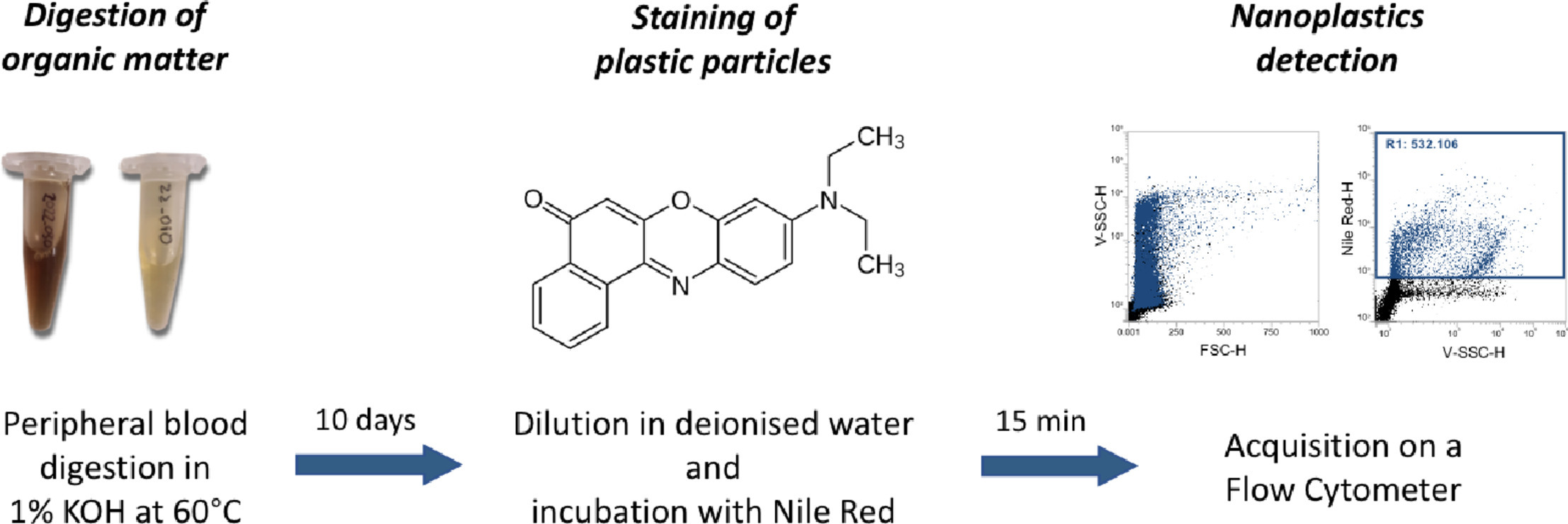New method for detecting nanoplastics in blood

A study uses for the first time flow cytometry to detect and measure nanoplastics in peripheral human blood. People with various medical conditions have been included in the study so as to investigate potential differences for nanoplastic accumulation across the population. In addition, mice have been used in a highly controlled environment to compare their nanoplastic levels to that of humans. This study, which has been published at the journal MethodsX, has had researchers from the Germans Trias i Pujol Research Institute (IGTP), and researchers associated to the Catalan Institute of Oncology (ICO), the Autonomous University of Barcelona (UAB), the Blood and Tissue Bank (BST), Lleida's Biomedical Research Institute (IRBLleida), Barcelona's Sant Joan de Déu Hospital, Thermo Fisher Scientific, and Sartorius Stedim North America.
Plastic accumulation in the environment is a growing concern worldwide. While the impact of large-size plastic debris is widely observed, the impact of smaller plastic particles on our health has not yet been thoroughly investigated. Exposure to microplastics and nanoplastics happens through essential activities, such as eating, drinking water, and breathing. This smaller plastic particles must be identified and measured, and their potential toxic effects on living organisms must be evaluated.
In this study, researchers have used fluorescence and nanocytometry techniques with Nile Red dye to show that nanoplastics can be detected in blood by flow cytometry. This fast, accurate and highly reproducible method represents a valuable tool for future studies on human plastic exposure. The authors have evaluated nanoplastic accumulation in seven mice and one cohort of 196 people which included regular blood donors, neonates and patients with and without haematological conditions.
The results show the presence of plastic nanoparticles in all subjects evaluated, both people and mice. Levels in human subjects show a high variability across groups: highest levels are observed in patients with acute lymphoblastic leukaemia and lowest levels are found in paediatric patients with type 1 diabetes. Regarding age-based differences, increasingly lower levels were found in subjects from 40 to 90 years old, suggesting that nanoplastics may accumulate in tissues, such as the fat tissue.
Researchers have advantageously been able to study people who live at Barcelona's metropolitan area, an urban area with higher levels of atmospheric pollution and exposure to plastic particles, to compare nanoplastic levels in this population with that of mice kept in a highly controlled environment. Analyses for mice kept at the Comparative Medicine and Bioimage Centre of Catalonia (CMCiB) show significantly lower levels of nanoplastics as compared to humans, suggesting that inhalation of plastics may play a more important role than previously thought. Therefore, further research is needed to investigate plastic accumulation at rural and remote populations in future studies.
Dr Jordi Petriz, from IGTP's Functional Cytomics Lab and principal investigator of the study, highlights the importance of this study for "understanding how exposure to plastic particles affects people's health and how these particles accumulate over time." Dr Petriz also notes that flow cytometry is a "new, simple technique for accurately detecting nanoplastics." Finally, Dr Petriz says that "in order to confirm an association between nanoplastic pollution and health, more research needs to be conducted."
Reference
Roser Salvia, Laura G. Rico, Jolene A. Bradford, Michael D. Ward, Michael W. Olszowy, Cristina Martínez, Álvaro Domingo Madrid-Aris, Joan R. Grífols, Águeda Ancochea, Laia Gomez-Muñoz, Marta Vives-Pi, Eva Martínez-Cáceres, Marco A. Fernández, Marc Sorigue, Jordi Petriz. Fast-screening flow cytometry method for detecting nanoplastics in human peripheral blood. MethodsX. 2023 Feb 15;10:102057. DOI: 10.1016/j.mex.2023.102057
